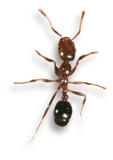Red Imported Fire Ant Pest Profile


Description
The fire ant worker is 1.6 to 6.0 mm in length, the minims being the smallest and the majors the largest. They vary in color from reddish brown to dark brown. Workers have 10-segmented antennae with a conspicuous 2-segmented apical club, a median clypeal tooth (usually), and lack a distinct tooth on the abdominal petiole.
History & Economic Importance
Red imported fire ant (RIFA), introduced in Alabama between 1933 and 1945, is a widespread pest in 11 southern states. Economic significance of the fire ant includes large nest mounds that damage agricultural equipment, negative impact on other species sharing portions of its niche, significant damage to agricultural crops, and painful stings that can be dangerous to sensitized people.
Distribution
Red imported fire ant is native along a narrow corridor through central South America extending from northwest of Porto Velho, Brazil to Santa Fe, Argentina. In the United States, it is found throughout the south and extends north into Tennessee and west into central Texas. Natural dispersal of approximately five miles a year occur through flight of mated females. Artificial spread is primarily by transport of queen-right colonies or mated queens in soil attached to plants or plant parts. This ant is expected to colonize all irrigated agricultural areas and lawns in California.
Life Cycle
Colony reproduction and nuptial flights occur throughout the year, usually after a rain when temperatures are warm enough. After swarming, the mated female drops to the ground, sheds her wings and begins burrowing into the soil. The first adults (minims) to hatch beg food from the queen, but begin foraging after three days. The minims then assume responsibility for brood care. As the colony size increases, improved feeding causes a greater proportion of larvae to become majors, stabilizing with 35 percent of the workers as majors in mature colonies. A colony matures sexually and produces alates at the end of the second year. Colonies average 27,000 workers after two years and 53,000 workers after three years. Very large, mature mounds may seasonally fluctuate between 120,000 and 230,000 workers. Workers live from two to four months and queens approximately seven years. Two or more ovipositing queens may occupy the same colony (polygyny). The polygynous colonies have more total ants per colony and sharply increased mound density per acre. Foraging activities of the colony are temperature and moisture dependent and in hot areas occur primarily at night and early morning. Mounds of mature colonies may be as high as 12 inches, but mounds may be absent in very warm localities. A single colony may forage over an area of about 1,900 square feet. Only 10 to 20 percent of the workers are foragers.
Host and Damage
Significant crop damage by fire ants can occur to emerging field and truck crops such as soybeans, eggplant and corn. The ants feed on the branches, new terminal growth, flowers, young fruit, bark, sap of tree crops, and will move into electrical control boxes of sprinklers and traffic lights.
